The X Button
Conflict and Chaos
by Todd Ciolek,

Game magazines are in trouble. Once-popular mainstays like EGM are dying off, and the publications that stick around are ill-equipped to compete with the Internet when it comes to news and pure visibility.
Hand-drawn games also face hard times, at least on non-portable systems. The upcoming Muramasa: The Demon Blade may be a beautiful game, but its traditional, two-dimensional look just isn't going to be noticed as much as, say, the latest pretty 3-D shooter with a name like Storm Junction Zone Zero.
However, the new issue of Play stumbled upon a way to make people notice both game magazines and big-budget, two-dimensional games: tentacles.

The surprise of seeing this cover on a mainstream publication is secondary to the surprise that neither Play nor Ignition Entertainment, Muramasa's publisher, specifically commissioned it. Play asked developer Vanillaware for exclusive cover art for Muramasa, and the above is what Vanillaware and its founder, George Kamitani, provided. As Ignition's Shane Bettenhausen points out, the illustration might reach back to The Dream of the Fisherman's Wife, an 1820s woodcut that stands as the earliest example of tentacle porn. It's a classical reference, kids!
All of this ties into Ignition's Muramasa launch party, to be held this Saturday at the Nintendo World Store in New York City. If you go, be sure to bring your new copies of Play magazine, just in case you have to lecture someone about the long and prestigious artistic legacy of women being molested by sea creatures.
NEWS
CAPCOM IN A GOOD MOOD, ANNOUNCES OKAMIDEN FOR THE DS
 There's something strangely cruel about Capcom making an Okami sequel for the DS. The paintbrush-driven gameplay of Okami is a perfect fit for the DS and its stylus, and the early screens of Okamiden suggest the same watercolor style that made the PlayStation 2 and Wii versions of the game so pretty. Unfortunately, there's no word on whether or not Platinum Games is involved with Okamiden, even though Platinum includes many of the people who made the original Okami at Clover Studio. Capcom shut down Clover after God Hand and Okami didn't move enough copies, and now Platinum is in thick with Sega. This makes it highly unlikely that Okami's original creators will touch its sequel, though perhaps fans should be grateful that Capcom cares enough to make that sequel in the first place.
There's something strangely cruel about Capcom making an Okami sequel for the DS. The paintbrush-driven gameplay of Okami is a perfect fit for the DS and its stylus, and the early screens of Okamiden suggest the same watercolor style that made the PlayStation 2 and Wii versions of the game so pretty. Unfortunately, there's no word on whether or not Platinum Games is involved with Okamiden, even though Platinum includes many of the people who made the original Okami at Clover Studio. Capcom shut down Clover after God Hand and Okami didn't move enough copies, and now Platinum is in thick with Sega. This makes it highly unlikely that Okami's original creators will touch its sequel, though perhaps fans should be grateful that Capcom cares enough to make that sequel in the first place.
LA PUCELLE RETURNS, GETS SLIGHTLY MORE EVIL
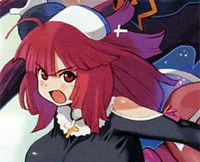 North America wasn't really fair to La Pucelle: Tactics, at least not in its PlayStation 2 version. Nippon Ichi Software created the game before making its powerhouse strategy-RPG Disgaea, but La Pucelle had the rotten luck of showing up in North America after the technically superior Disgaea. Yet NIS rarely leaves a game resting at just one version, and La Pucelle is headed for the Japanese PSP this November as La Pucelle: Ragnarok.
North America wasn't really fair to La Pucelle: Tactics, at least not in its PlayStation 2 version. Nippon Ichi Software created the game before making its powerhouse strategy-RPG Disgaea, but La Pucelle had the rotten luck of showing up in North America after the technically superior Disgaea. Yet NIS rarely leaves a game resting at just one version, and La Pucelle is headed for the Japanese PSP this November as La Pucelle: Ragnarok.
The game's story stays the same: Prier, a bratty nun-in-training, sets out to become the Maiden of Light, butting heads with her fellow church acolytes and powers both higher and lower. The game uses a rough version of what would later become Disgaea's battle engine, with characters maneuvering themselves on grids and teaming up to pelt enemies. Ragnarok adds the usual minor improvements (more voice, the option to remove combat animations) and another four chapters that feature Prier's evil incarnation. Disgaea's lead trio of Etna, Flonne, and Laharl also shows up in Ragnarok, which seems appropriate considering Prier's cameo in the original Disgaea.
LEVEL 5'S FANTASY LIFE ISN'T MOTHER 4, BUT IT'LL DO
 Level-5 frequently puts together sprawling RPGs like Rogue Galaxy and Dragon Quest VIII, but the developer's best games come from the focused, whimsical Professor Layton series. With that in mind, it's comforting to see Level-5's latest go the more humble route with Fantasy Life.
Level-5 frequently puts together sprawling RPGs like Rogue Galaxy and Dragon Quest VIII, but the developer's best games come from the focused, whimsical Professor Layton series. With that in mind, it's comforting to see Level-5's latest go the more humble route with Fantasy Life.
Set in the possibly doomed realm of Fantazeal, Fantasy Life for the DS gives the player's avatar, male or female, the freedom to pick a job and head off on everyday tasks. Wandering around the town, said player-named worker makes a living as a world-ending prophecy looms overhead. The game resembles some mixture of Harvest Moon mechanics and pleasant hand-drawn artwork, and it's even drawn a few comparisons to Mother 3's appearance. That's understandable, since Fantasy Life co-developer Brownie Brown programmed Mother 3. Brownie's not the only experienced name on the project, either; Nobuo Uematsu adds the soundtrack and Little King's Story designer Hideo Manaba crafts the characters.
IN BRIEF: DAEMON BRIDE DEBUTS, AGAREST DODGES AWFUL COVER
With Blazblue out, the next big 2-D fighter for anime fans is Examu's Daemon Bride, with its exceptionally gothic angel-and-demon roster. Daemon Bride arrived in Japanese arcades recently, just cracking the Arcadia top ten. That's not a bad debut for a fighting game with relatively little mainstream push, even if it's barely rating above the ten-year-old Street Fighter III: 3rd Strike.
As a fan of horrible box art, I can't resist showing the cover that Ghostlight almost used for the European edition of Agarest: Generations of War.

For some reason, this did not sit well with fans, and the game now has a cover much more in line with its actual art, plus a special edition cover that's basically the Japanese one with an English title and rating. Aksys Games, meanwhile, plans to avoid the need for any cover at all by releasing the game in North America as the download-only Agarest War.
REVIEW: DISSIDIA: FINAL FANTASY
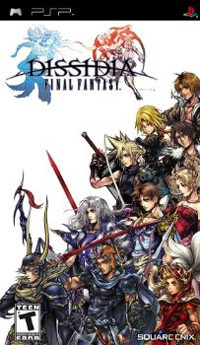 Developer: Square Enix
Developer: Square Enix
Publisher: Square Enix
Platform: PSP
Players: 1-2 (ad-hoc)
MSRP: 39.99
A Final Fantasy fighting game lies in a mysterious space somewhere between the shameful cash-in and the potentially awesome genre hybrid. Sure, it's a rehash of material from Final Fantasies past, but those very Final Fantasies were littered with extravagant attacks and visual effects, such that some bitter fans would consider the games better off as fighters than RPGs. Dissidia bridges that little gap. Unlike 1999's Ehrgeiz, it's not some mediocre 3-D fighter with half a dozen Final Fantasy VII characters piggybacking along. Dissidia is a full-fledged Final Fantasy fighter and a tribute to all of the franchise's main games, whether you care about them or not.
It's tempting to forgo any discussion of Dissidia's storyline, as the game almost admits that it's a mere excuse for crossovers: Chaos, prime villain from the first Final Fantasy, strikes a blow at the goddess Cosmos, creating some universe-wide crisis that leaves ten warriors left to set things to rights. Those ten heroes all hail from Final Fantasies: A Warrior of Light from Final Fantasy, Firion from Final Fantasy II, the Onion Knight from Final Fantasy III, Cecil from Final Fantasy IV, Bartz from Final Fantasy V; Terra from Final Fantasy VI, Cloud from Final Fantasy VII, Squall from Final Fantasy VIII, Zidane from Final Fantasy IX; and Tidus from Final Fantasy X. Each is joined by his or her game's major villain, including Final Fantasy VI's Kefka, Final Fantasy VII's Sephiroth, or Final Fantasy III's big feminized cloud of darkness. Special appearance are made by Final Fantasy XI's Shantotto and XII's Judge Gabranth.
As an arena fighter, Dissidia doesn't resemble the quick, up-close brawls of Tekken or Soul Calibur. Instead, Final Fantasy heroes and villains clash in huge areas sparsely littered with obstacles, and each warrior throws two types of attack: HP strikes and BP strikes. HP moves deplete an opponent's HP, ending the match if it gets to zero. BP attacks actually transfer your opponent's depleted BP to your own reserves, leaving that opponent very vulnerable if his or her BP drops to zero.
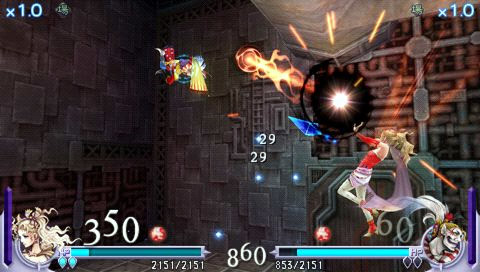
Dissidia plays in broad territory. Characters hurl glitzy, large-scale attacks, and the arenas reflect that. With plenty of running-and-flying space, actually hitting a foe can be a challenge, and you'd best forget about landing deep-hit strikes or crossover combos or anything else you'd find in a tight, balanced production. Dissidia's slower, projectile-heavy combat and often uncooperative camera will quickly alienate those in search of a “real” fighting game.
Final Fantasy fans, however, will be too busy spotting all of the references and writing fan fiction about them. Cecil switches from a dark knight to a paladin mid-battle, Tidus kicks Blitzballs, Kefka lopes around while cackling like the lunatic he is, and just about every character with personality shows some callback to an older Final Fantasy. Dissidia's visual quality is incredible for the PSP, pushing the system with beautiful effects and excellent character models, though I imagine they're both helped by comparatively empty scenery. The voice-acting stays mostly above average, though some of the cast aren't given much to work with beyond “The Light guide me!” The music throws in new songs with remixes of older tracks from throughout the series, though that might be lost on anyone who's never owned actual Final Fantasy soundtracks.

It's the combat that fuels Dissidia, of course, and there's a lot going on despite the loose approach. In addition to choosing between HP and BP attacks, characters can run freely, jump, wall-run, guard, throw out button-mashing combos, and air-dash so much that they're effectively flying. Filled by inflicting damage and grabbing items, a special gauge puts a warrior into “EX mode” with boosted attack power and special attacks that many Final Fantasy fans will recognize. On the whole, it's an enjoyable little system, if not a terribly deep one. Fights gradually fall into clear patterns, but there's usually some new minor strategy to be explored, and there's undeniable energy to Dissidia's chaotic aerial battles.
Unlike nearly every other fighting game in recent memory, Dissidia plays up its solo mode instead of its player-versus-player element. The game's one-player quests send each of the ten characters through a series of board-game levels littered with treasures, enemies, and various equipment and stat bonuses. The RPG origins of Dissidia come into play here, and it's all for the better. It's a shame that most of the "monsters" are just glowing versions of other heroes, but the somewhat repetitive open-field battles grow much more interesting when you can level-up characters, swap in new attacks, and discover better equipment. There's even a Moogle mail system that quizzes the player on the nerdiest possible points of Final Fantasy history. In comparison to the extensive single-player offerings, the versus mode is anemic, with only ad-hoc play available in place of a full online search.
The storyline is far less compelling. Each quest is fairly long and focuses on a distinct character, usually paired with others in shallow ways; the Onion Knight hangs with Terra (who seems even more insecure than she was at the start of Final Fantasy VI), while Squall tries to remain alone because he's a jerk. Most of the alleged character development recycles the heroes' familiar stories in abbreviated form, and even when the game strings along subplots about the villains, it's fluffier than even the dumbest parts of Kingdom Hearts II.
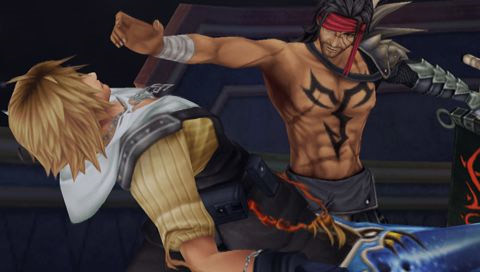
There's another reason that Dissidia's story mode rings hollow. In order to pay homage to every numbered Final Fantasy, Square Enix picked a hero and villain from each. While the villains show some diverse styles, the heroes' side of the roster consists almost entirely of pretty, pale-haired men in outfits of escalating gaudiness. I'm sure this will please some audiences, but the supporting characters of Final Fantasy are often more memorable than the main heroes, or at least better suited to a fighting game. Popular as the first three Final Fantasies are, I doubt any fan ever burned to play their main characters in a fighter. I'd much prefer someone, anyone from Final Fantasy Tactics, perhaps the best game in the entire franchise.
And that's Dissidia's biggest problem: the cast is more likely to remind fans of who isn't present. They won't see Final Fantasy IV's Rydia hurling summoned monsters with each attack. They won't see Final Fantasy XII's Balthier sniping at enemies from across the playfield (Final Fantasy XII gets screwed here, since only its villain shows up). They won't see Yuffie, Edge, Shadow, or any other ninja, even though a fighting game should demand one. They won't see Final Fantasy IX's dimwitted eating-monster Quina Quen temporarily devouring foes to gain their powers. Poor Quina Quen. Only I understand you.
It's hard to call Dissidia a complete success. As a fighter, it's a little too shallow to draw in devoted fans for extended play. As giant, glue-filled trap for Final Fantasy enthusiasts, it doesn't reach its full potential, as the game puts the blander heroes and villains alongside the interesting ones. Still, Dissidia merits a rental at the very least. The Final Fantasy tribute is halfhearted, but its fusion of free-range fighting and RPG mechanics keeps going strong well after the novelty of Sephiroth fighting Cecil wears away.
RELEASES FOR THE WEEK OF 9-6
DISGAEA 2: DARK HERO DAYS I wonder if any other cult-hit RPG series could get away with Disgaea's habit of jumping from one system after another, adding little extras with each iteration. Hell, even Final Fantasy remakes try to overhaul their graphics now and then. To be fair, Disgaea 2: Dark Hero Days has quite a few enhancements compared to 2006's Disgaea 2: Cursed Memories, as the new version uses the magichange system from Disgaea 3, allowing monster characters to transform into temporary weapons. Dark Hero Days also features Disgaea 3's Mao and, as the subtitle implies, a new story mode starring Axel, the self-aggrandizing “dark hero” of the original Disgaea 2. This might not affect the main plot and its hero, Adell. Out to avenge his human family being cursed with monstrous forms (which none of them seems to mind), Adell accidentally summons Rozalin, daughter of the very demon overlord Adell hopes to slay. Many fourth-wall jokes and crazed strategic battles ensue, complete with Prinny penguin-demons, the Disgaea franchise's most popular character(s). There's also an appearance by Etna, the demon girl who's probably the franchise's second most popular character, for reasons that might one day get some of her fans locked up.
|
RAIDEN IV Developer: Moss
Developer: Moss Publisher: UFO Interactive Platform: Xbox 360 Players: 1-2 MSRP: 39.99 UFO Interactive's 2007 release of Raiden III apparently did better business than I realized. That, or the arrival of Raiden Fighters Aces on the Xbox 360 made someone eager to release more 2-D shooters, or just more Raiden. I prefer the latter theory, since Raiden Fighters Aces was enjoyable and Raiden III was staggeringly bland. Raiden IV is, unfortunately, the creation of the same people that made III, though IV has a larger variety of weapons (including some new to the Xbox 360 version). It also brings back the best thing about Raiden III: flying two ships with one controller. Each fighter gets one analog stick to control movement, with the shoulder buttons firing weapons. It livens up even the dullest shooter, if only for a little while. Strangely enough, Raiden IV isn't the usual bare-bones package, as GameStop offers a bonus soundtrack CD featuring remixes by INH's Go Sato and Akira Sato.
|
VALHALLA KNIGHTS: ELDAR SAGA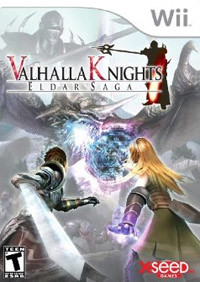 Developer: K2 LLC
Developer: K2 LLC Publisher: XSEED Games Platform: Wii Players: 1-2 (online) MSRP: 39.99 The previous two PSP-based Valhalla Knights games would be high-level stumpers on a quiz show called “Where Was This Game Made?” Developer K2 is the same Japanese outfit that gave us a bunch of recent Tenchu games, but the Valhalla Knights series hides its origins under a generic fantasy aura. Arriving on the Wii, Eldar Saga is a grim, workmanlike action-RPG where character customization and selective quests drive off the usual anime heroes and pink-haired elf amazons. Of course, you can make elves and humans and other standard Dungeons and Dragons groups, spanning a promised 10,000 combinations of job classes and races. It looks like the sort of online RPG that could just as easily come from Korea or the Ukraine or Texas, though Valhalla Knights cuts down its adventuring to just two players online. Sometimes it's better to play with a single reliable partner. And sometimes it's not.
|
EXTRA LIVES: SD LUPIN III: KINKO YABURI DAISAKUSEN
 Anime-based games rarely miss a chance to take the path of least effort, so it's strange when they overlook a quick, cheap, and fairly good idea. You know Lupin III, the scrawny thief who steals priceless treasures and occasionally saves the world, all while evading Interpol and copyright laws? Wouldn't that lend itself really well to a maze-based puzzle game? You'd think so, but most of the Lupin games end up as action titles or tedious digital comics. It took a while for someone to make a puzzle-action title, SD Lupin III: Kinko Yaburi Daisakusen, and it showed up on that haven for puzzle-action titles, the original Game Boy.
Anime-based games rarely miss a chance to take the path of least effort, so it's strange when they overlook a quick, cheap, and fairly good idea. You know Lupin III, the scrawny thief who steals priceless treasures and occasionally saves the world, all while evading Interpol and copyright laws? Wouldn't that lend itself really well to a maze-based puzzle game? You'd think so, but most of the Lupin games end up as action titles or tedious digital comics. It took a while for someone to make a puzzle-action title, SD Lupin III: Kinko Yaburi Daisakusen, and it showed up on that haven for puzzle-action titles, the original Game Boy.
Few Game Boy puzzle games pushed great visuals, and SD Lupin III offers simple grids, with Lupin and various foes running across them. Lupin, apparently unarmed, can only jump across gaps or leap up and down on squares, thus raising them up higher. While this seldom avoids an enemy, bumping a square to a greater height gives our hero more jumping distance, adding a hint of the third dimension to the game's otherwise flat puzzles.
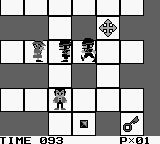 Getting through each level involves a key and a treasure, though many different types of square present themselves along the way. Some let Lupin attack enemies in four cardinal directions, some send him sliding across (and off) the board, some disintegrate beneath his feet, and the most important ones rearrange the entire grid. The puzzles can get particularly tough later on, as a time limit, laser barriers and multiple grid-reshufflers show up.
Getting through each level involves a key and a treasure, though many different types of square present themselves along the way. Some let Lupin attack enemies in four cardinal directions, some send him sliding across (and off) the board, some disintegrate beneath his feet, and the most important ones rearrange the entire grid. The puzzles can get particularly tough later on, as a time limit, laser barriers and multiple grid-reshufflers show up.
Much like Pac-Man, Lupin is hounded by familiar enemies. In ascending order of difficulty, his foes include Inspector Koichi Zenigata, Count Cagliostro of The Castle of Cagliostro, Mamo of The Secret of Mamo, the robots that Hayao Miyazaki created for his Aloha, Lupin TV episode (and reused for Castle in the Sky), and Pycal, who no one seems to remember when it comes to Lupin nemeses. Each villain is joined by doubles or some sidekick: Cagliostro gets his Euro-ninjas, while Zenigata has police officers to aid in the chase. The designers probably knew that Zenigata never catches Lupin and helps him more often than not, but accuracy wasn't SD Lupin III's focus. In fact, it ignores Lupin's sidekicks Jigen and Goemon for most of the game, limiting them to screen-sweeping cameos.
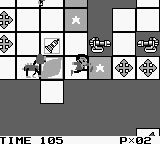 Hailing from the Game Boy's first year on the market, SD Lupin III is allowed some simplicity. It looks and sounds fair enough, with large character sprites and a cute little defeated Lupin to signal failure. Aside from drab designs, the game's only major flaw lies in control: Lupin and the other characters move one large square at a time. The resulting stages are basic stuff, rarely reaching the complexity of The Adventures of Lolo or the energy of a good Pac-Man clone.
Hailing from the Game Boy's first year on the market, SD Lupin III is allowed some simplicity. It looks and sounds fair enough, with large character sprites and a cute little defeated Lupin to signal failure. Aside from drab designs, the game's only major flaw lies in control: Lupin and the other characters move one large square at a time. The resulting stages are basic stuff, rarely reaching the complexity of The Adventures of Lolo or the energy of a good Pac-Man clone.
SD Lupin III is built on a good idea, but few puzzle fans will find it enticing, and fewer Lupin fans will tolerate the limited appearances of favorite characters. It's a novelty for the Lupin collector, who probably has many worse things already in his or her collection. The Legend of the Gold of Babylon, for example.
Bare cartridges of SD Lupin III: Kinko Yaburi Daisakusen come relatively cheap, as do many Japanese Game Boy offerings. Copies with boxes and manuals are much more expensive, and that goes for just about any old Game Boy title you'll find here or in Japan.
discuss this in the forum (59 posts) |
this article has been modified since it was originally posted; see change history
 Developer: NIS
Developer: NIS